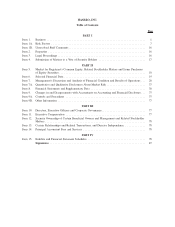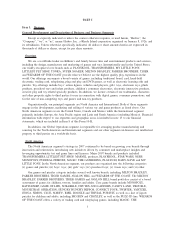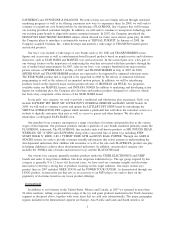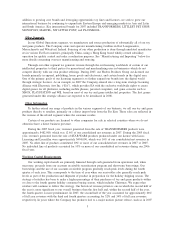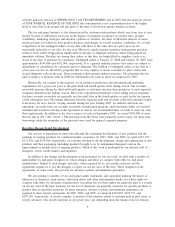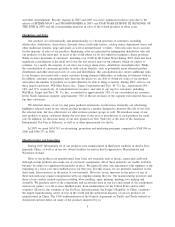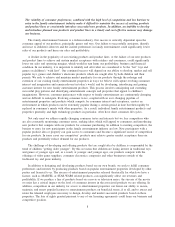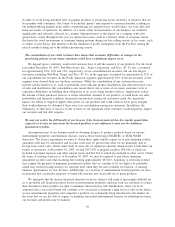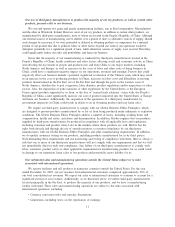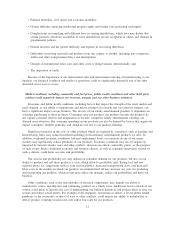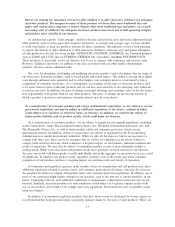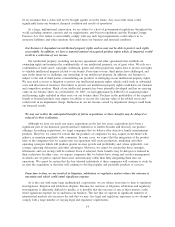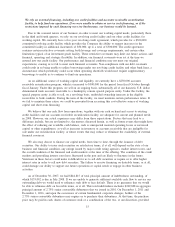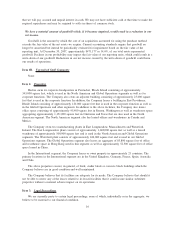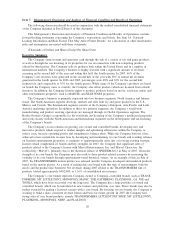Hasbro 2007 Annual Report Download - page 18
Download and view the complete annual report
Please find page 18 of the 2007 Hasbro annual report below. You can navigate through the pages in the report by either clicking on the pages listed below, or by using the keyword search tool below to find specific information within the annual report.in order to avoid losing potential sales of popular products or producing excess inventory of products that are
less popular with consumers. Our failure to accurately predict and respond to consumer demand, resulting in
our underproducing popular items and/or overproducing less popular items, would reduce our total sales and
harm our results of operations. In addition, as a result of the seasonal nature of our business, we would be
significantly and adversely affected, in a manner disproportionate to the impact on a company with sales
spread more evenly throughout the year, by unforeseen events, such as a terrorist attack or economic shock,
that harm the retail environment or consumer buying patterns during our key selling season, or by events, such
as strikes or port delays, that interfere with the shipment of goods, particularly from the Far East, during the
critical months leading up to the holiday purchasing season.
The consolidation of our retail customer base means that economic difficulties or changes in the
purchasing policies of our major customers could have a significant impact on us.
We depend upon a relatively small retail customer base to sell the majority of our products. For the fiscal
year ended December 30, 2007, Wal-Mart Stores, Inc., Target Corporation, and Toys “R” Us, Inc., accounted
for approximately 24%, 12% and 11%, respectively, of our consolidated net revenues and our five largest
customers, including Wal-Mart, Target and Toys “R” Us, in the aggregate accounted for approximately 52% of
our consolidated net revenues. In the North American segment, approximately 70% of the net revenues of the
segment were derived from our top three customers. While the consolidation of our customer base may
provide certain benefits to us, such as potentially more efficient product distribution and other decreased costs
of sales and distribution, this consolidation also means that if one or more of our major customers were to
experience difficulties in fulfilling their obligations to us, cease doing business with us, significantly reduce
the amount of their purchases from us or return substantial amounts of our products, it could harm our sales,
profitability and financial condition. Increased concentration among our customers could also negatively
impact our ability to negotiate higher sales prices for our products and could result in lower gross margins
than would otherwise be obtained if there were less consolidation among our customers. In addition, the
bankruptcy or other lack of success of one or more of our significant retail customers could negatively impact
our revenues and bad debt expense.
We may not realize the full benefit of our licenses if the licensed material has less market appeal than
expected or if sales revenue from the licensed products is not sufficient to earn out the minimum
guaranteed royalties.
An important part of our business involves obtaining licenses to produce products based on various
entertainment properties and theatrical releases, such as those based upon MARVEL or STAR WARS
characters. The license agreements we enter to obtain these rights usually require us to pay minimum royalty
guarantees that may be substantial, and in some cases may be greater than what we are ultimately able to
recoup from actual sales, which could result in write-offs of significant amounts which in turn would harm our
results of operations. At December 30, 2007, we had $137,959 of prepaid royalties, $94,616 of which are
included in prepaid expenses and other current assets and $43,343 of which are included in other assets. Under
the terms of existing contracts as of December 30, 2007, we may be required to pay future minimum
guaranteed royalties and other licensing fees totaling approximately $87,815. Acquiring or renewing licenses
may require the payment of minimum guaranteed royalties that we consider to be too high to be profitable,
which may result in losing licenses we currently hold when they become available for renewal, or missing
business opportunities for new licenses. Additionally, as a licensee of entertainment based properties we have
no guaranty that a particular property or brand will translate into successful toy or game products.
We anticipate that the shorter theatrical duration for movie releases will make it increasingly difficult for
us to profitably sell licensed products based on entertainment properties and may lead our customers to reduce
their demand for these products in order to minimize their inventory risk. Furthermore, there can be no
assurance that a successful brand will continue to be successful or maintain a high level of sales in the future,
as new entertainment properties and competitive products are continually being introduced to the market. In
the event that we are not able to acquire or maintain successful entertainment licenses on advantageous terms,
our revenues and profits may be harmed.
10


